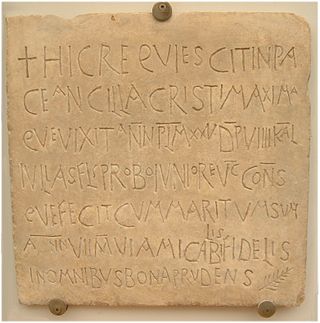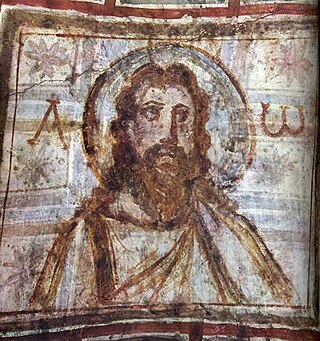Related Research Articles

The Catacombs of Rome are ancient catacombs, underground burial places in and around Rome, of which there are at least forty, some rediscovered since 1578, others even as late as the 1950s.

The Basilica Papale di San Lorenzo fuori le mura is a Roman Catholic papal minor basilica and parish church, located in Rome, Italy. The Basilica is one of the Seven Pilgrim Churches of Rome and one of the five papal basilicas, each of which was assigned to the care of a Latin Church patriarchate. The basilica was assigned to the Patriarchate of Jerusalem. The basilica is the shrine of the tomb of its namesake, Lawrence, one of the first seven deacons of Rome who was martyred in 258. Many other saints and Pope Pius IX are also buried at the Basilica, which is the centre of a large and ancient burial complex.

Saints Protus and Hyacinth were Christian martyrs during the persecution of Emperor Valerian. Protus' name is sometimes spelled Protatius, Proteus, Prothus, Prote, and Proto. His name was corrupted in England as Saint Pratt. Hyacinth is sometimes called by his Latin name Hyacinthus. The day of their annual commemoration is mentioned in the "Depositio Martyrum" on September 11, in the Chronograph of 354.

Nereus and Achilleus are two Roman martyr saints. In the present General Roman Calendar, revised in 1969, Nereus and Achilleus (together) are celebrated on 12 May.

Saint Hermes, born in Greece, died in Rome as a martyr in 120, is venerated as a saint by the Catholic Church and the Eastern Orthodox Church. His name appears in the Martyrologium Hieronymianum as well as entries in the Depositio Martyrum (354). There was a large basilica over his tomb that was built around 600 by Pope Pelagius I and restored by Pope Adrian I. The Catacomb of Sant'Ermete on the Salarian Way is named after him.

Early Christian inscriptions are the epigraphical remains of early Christianity. They are a valuable source of information in addition to the writings of the Church Fathers regarding the development of Christian thought and life in the first six centuries of the religion's existence. The three main types are sepulchral inscriptions, epigraphic records, and inscriptions concerning private life.

The Catacomb of Saint Agnes is one of the catacombs of Rome, placed at the second mile of via Nomentana, inside the monumental complex of Sant'Agnese fuori le mura, in the Quartiere Trieste.
The Catacombs of San Valentino is one of the catacombs of Rome (Italy), placed at the 2nd mile of the via Flaminia, now in Viale Maresciallo Pilsudski, in the modern Pinciano neighborhood.

The Catacombs of Commodilla or Catacombs of Felix and Adauctus is a three-level underground burial complex forming one of the catacombs of Rome. It is sited on via delle Sette Chiese, not very far from via Ostiense, in the Ostiense quartiere. One name derives from its founder or the donor of the land on which it was built, whilst the other its after the two main martyrs buried there, Felix and Adauctus.

The Catacombs of Domitilla are an underground Christian cemetery named after the Domitilla family that had initially ordered them to be dug. Located in Rome, Italy, are the human-made subterranean passageways used for cemeteries and religious practice. They are among the largest catacombs in Rome, spreading out 17 km, largely along the ancient Via Ardeatine, laid out on four levels, and housing approximately 15,000 bodies underground. The Catacombs of Domitilla are the only catacombs in Rome that have an underground Basilica and are one of only five Roman catacombs open to the public. Constructed during the second and third centuries, this labyrinth of underground passages contains frescoes and a wealth of Christian iconography while also presenting masterful engineering skills and innovative architectural techniques.

The Catacomb of Santi Marco e Marcelliano is a catacomb between the ancient via Appia antica and via Ardeatina in what is now the Ardeatino district of Rome. With the catacomb of Callixtus and the Catacomb of Balbina, it is one of three catacombs in the Callixtian Complex between the via Appia antica, via Ardeatina and vicolo delle Sette Chiese.
The Catacomb of Saints Processus and Martinianus is one of the catacombs of Rome. Sited on the via Aurelia, no ancient remains have been conclusively identified as being it.
The ad Clivum Cucumeris Catacomb was one of the catacombs of Rome, sited on the ancient via Salaria according to ancient sources but not yet conclusively identified with any surviving ancient remains.
The Catacomb of the Iordani is a catacomb on the left side of the ancient via Salaria in Rome, under the modern villa Ada in the Parioli quarter. It is named after the family who owned the land in which it was excavated and was badly damaged by relic-hunters and tomb-robbers before being rediscovered.

The Catacomb of Sant'Ippolito is a catacomb on the via Tiburtina in Rome, now entered from via dei Canneti in the modern Nomentano quartiere.
The Catacombs of Santa Felicita or Catacomb of Maximus is a three-level complex of catacombs on the modern via Salaria in the modern Salario quarter of Rome. In the 17th century it was also known as the Catacomb of Sant'Antonio after the patron saint of the Vienne monastery which owned the land in which it fell.

The Catacomb of Santi Gordiano e Epimaco is a catacomb on the ancient via Latina in Rome, near the Aurelian Wall and piazza Galeria in the Appio-Latino quarter. Only some of its galleries have been found and excavated - archaeologists believe it to be a much larger necropolis on several levels, with inscriptions from Julian's reign showing it to have still been in use at that date.
The Catacomb of San Panfilo is one of the catacombs of Rome, sited under via Paisiello and via Spontini in the Pinciano quarter and along the line of the ancient route of the via Salaria. It is named after the Carthaginian martyr Pamphilus. The modern-day entrance is in Santa Teresa del Bambin Gesù in Panfilo. The ancient sources identify it as the first catacomb on the via Salaria starting from porta Pinciana.

The Catacomb of San Nicomede was a catacomb at the start of the via Nomentana near the modern Porta Pia in the Nomentano quarter, though its precise location is still unknown.
The Catacomb of Trasone is a catacomb on the left side of the ancient via Salaria, at its junction with via Yser, in the modern-day Parioli quarter of Rome. Begun in the 3rd century, is named after Trason or Thrason, a rich Christian Roman citizen under Diocletian and the owner of the land in which it was dug - he is named in a martyrdom account of Susanna of Rome. Ancient sources also call it Coemeterium Thrasonis ad s. Saturninum (the cemetery of Thrason at [the basilica of] saint Saturninus in memory of the main martyr buried there, the remains of whose above-ground basilica were still visible late in the 16th century.
References
- ↑ (in Italian) Maddalena Marrucci an Mariangela Summa, 'CONSIDERAZIONI SULLA SALARIA VETUS ALLA LUCE DEI RITROVAMENTI DI VIA G. PUCCINI E VIALE G. ROSSINI (ROMA)', in Bollettino di Archeologia online, III, n. 3-4, MiBAC - Direzione generale per le Antichità, 2012
- ↑ (in Italian) Carletti C., Iscrizioni cristiane inedite del cimitero di Bassilla “ad S. Hermetem”, in Memorie della Pontificia Accademia Romana di Archeologia 8, II, 1976